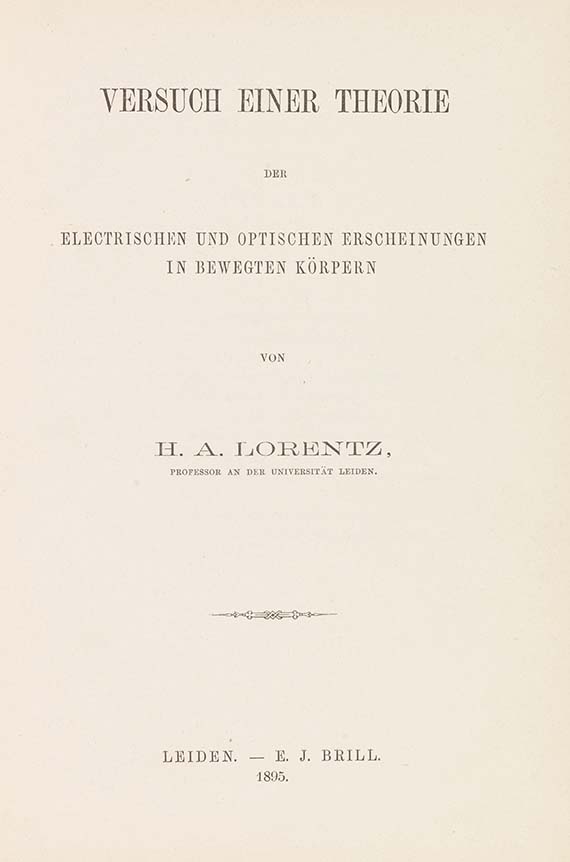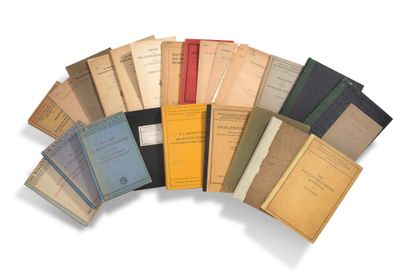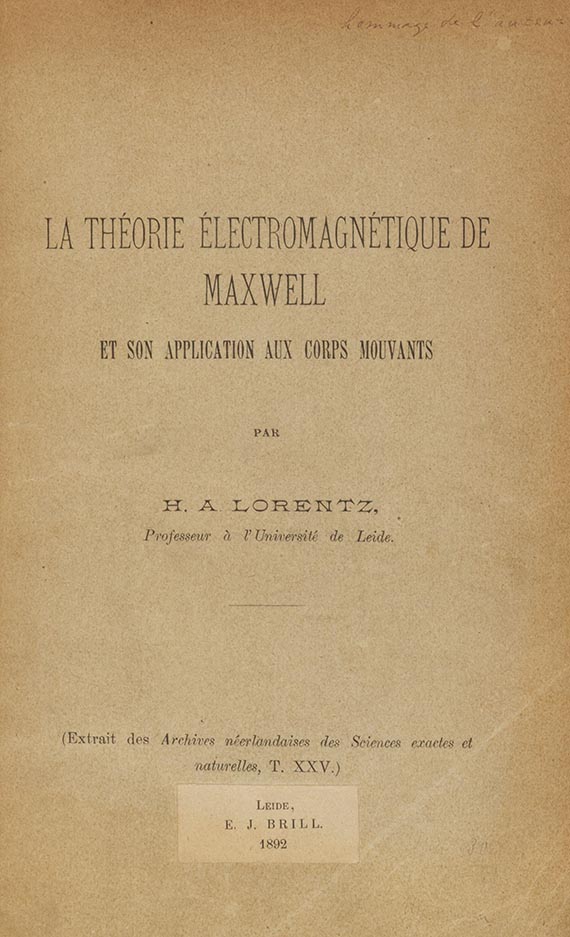LORENTZ, Hendrik Antoon (1853-1928). Versuch einer Theorie der elctrischen und optischen Erscheinungen in bewegten Krpern . Leiden: E. J. Brill, 1895. 8 o (225 x 148 mm). (Faint marginal dampstaining at front and back.) Modern half leather, original printed wrappers preserved. Provenance : author's presentation copy (inscribed "vom Verf[asser]" on front wrapper), presumably to: Svante Arrhenius (1859-1927), recipient of the Nobel Prize in physics for 1903 for his theory of electrolytic dissociation (commemorative bookplate inside front wrappers of both works [see below]); Stockholm, Kungl. Vetenskapsakademiens (Academy of Sciences) Bibliotek (bookplate and inkstamps, printed slip indicating "Docent Arrhenius" as owner tipped in at end of second work). PRESENTATION COPY OF THE FIRST EDITION of the second of Lorentz's two expositions of his electron theory of matter (the first article appeared in 1892), THE MATHEMATICAL FOUNDATION FOR EINSTEIN'S SPECIAL THEORY OF RELATIVITY. "Hertz's experimental and theoretical researches generated widespread interest in Maxwell's theory among Continental physicists. Of the major theoretical statements of Maxwellian electrodynamics following Hertz's researches, several advanced a molecular view of electricity together with a stationary ether. Such theories--soon to be called electron theories--were proposed independently in the early 1890's by Lorentz, by Wiechert, and by Larmor... Of the three theories, Lorentz' gained the greatest authority on the Continent, in part because of its clear, if ultimately unsatisfactory, dualism of electron and field" (DSB). Lorentz's theory, for which he won the Nobel Prize in physics in 1902 (shared with Pieter Zeeman), rested on the "fundamentally new assumption that the behavior of light and matter could be understood in terms of charged particles" (Norman). His articles contain the mathematical explanation of the results of the Michelson-Morley experiment (see lot 1199), one of several "ether-drift" experiments that had disproved the theory that the speed of light is interfered with by the "luminiferous ether" that was still believed to surround the earth. The ether theory had attempted to explain the so-called "angle of aberration," the fact that in examining any fixed star it is necessary to point the telescope a bit in advance of the star. In this second paper Lorentz explained the optical aberration by his "famous contraction hypothesis" (DSB), proposed independently at the same time by the Irish physicist George F. Fitzgerald, which assumes that matter is of an electrical nature, so that "all electrical particles become shortened when in motion along the direction in which the ether drifts" (PMM). In 1905 Einstein published his special theory of reativity, which refuted the Michelson-Morley experiment as fundamentally flawed since it presumed the existence of an observer independent of and unrelated to the universe, and for which he adopted the equations of Lorentz's theory. "Einstein argued in 1905 that the ether of the electron theory and the related notions of absolute space and time were superfluous or unsuited for the development of a consistent electrodynamics". Although Lorentz admired Einstein's reinterpretations of his equations, "to the end of his life he believed that the ether was a reality and that absolute space and time were meaningful concepts" (DSB). VERY FINE ASSOCIATION COPY, LINKING TWO NOBEL LAUREATES IN PHYSICS. PMM 378(b); Norman 1388. [ Bound with :] LORENTZ. Sichtbare und unsichtbare Bewegungen . Translated by Georg Siebert. Braunschweig: Friedrich Viewig und Sohn, 1902. 8 o. Line block illustrations. (Bookplate obscuring notice inside front wrapper.) First German edition of Lorentz's Zichtbare en onzichtbare Bewegingen (Leiden, 1901). Norman 1389.
LORENTZ, Hendrik Antoon (1853-1928). Versuch einer Theorie der elctrischen und optischen Erscheinungen in bewegten Krpern . Leiden: E. J. Brill, 1895. 8 o (225 x 148 mm). (Faint marginal dampstaining at front and back.) Modern half leather, original printed wrappers preserved. Provenance : author's presentation copy (inscribed "vom Verf[asser]" on front wrapper), presumably to: Svante Arrhenius (1859-1927), recipient of the Nobel Prize in physics for 1903 for his theory of electrolytic dissociation (commemorative bookplate inside front wrappers of both works [see below]); Stockholm, Kungl. Vetenskapsakademiens (Academy of Sciences) Bibliotek (bookplate and inkstamps, printed slip indicating "Docent Arrhenius" as owner tipped in at end of second work). PRESENTATION COPY OF THE FIRST EDITION of the second of Lorentz's two expositions of his electron theory of matter (the first article appeared in 1892), THE MATHEMATICAL FOUNDATION FOR EINSTEIN'S SPECIAL THEORY OF RELATIVITY. "Hertz's experimental and theoretical researches generated widespread interest in Maxwell's theory among Continental physicists. Of the major theoretical statements of Maxwellian electrodynamics following Hertz's researches, several advanced a molecular view of electricity together with a stationary ether. Such theories--soon to be called electron theories--were proposed independently in the early 1890's by Lorentz, by Wiechert, and by Larmor... Of the three theories, Lorentz' gained the greatest authority on the Continent, in part because of its clear, if ultimately unsatisfactory, dualism of electron and field" (DSB). Lorentz's theory, for which he won the Nobel Prize in physics in 1902 (shared with Pieter Zeeman), rested on the "fundamentally new assumption that the behavior of light and matter could be understood in terms of charged particles" (Norman). His articles contain the mathematical explanation of the results of the Michelson-Morley experiment (see lot 1199), one of several "ether-drift" experiments that had disproved the theory that the speed of light is interfered with by the "luminiferous ether" that was still believed to surround the earth. The ether theory had attempted to explain the so-called "angle of aberration," the fact that in examining any fixed star it is necessary to point the telescope a bit in advance of the star. In this second paper Lorentz explained the optical aberration by his "famous contraction hypothesis" (DSB), proposed independently at the same time by the Irish physicist George F. Fitzgerald, which assumes that matter is of an electrical nature, so that "all electrical particles become shortened when in motion along the direction in which the ether drifts" (PMM). In 1905 Einstein published his special theory of reativity, which refuted the Michelson-Morley experiment as fundamentally flawed since it presumed the existence of an observer independent of and unrelated to the universe, and for which he adopted the equations of Lorentz's theory. "Einstein argued in 1905 that the ether of the electron theory and the related notions of absolute space and time were superfluous or unsuited for the development of a consistent electrodynamics". Although Lorentz admired Einstein's reinterpretations of his equations, "to the end of his life he believed that the ether was a reality and that absolute space and time were meaningful concepts" (DSB). VERY FINE ASSOCIATION COPY, LINKING TWO NOBEL LAUREATES IN PHYSICS. PMM 378(b); Norman 1388. [ Bound with :] LORENTZ. Sichtbare und unsichtbare Bewegungen . Translated by Georg Siebert. Braunschweig: Friedrich Viewig und Sohn, 1902. 8 o. Line block illustrations. (Bookplate obscuring notice inside front wrapper.) First German edition of Lorentz's Zichtbare en onzichtbare Bewegingen (Leiden, 1901). Norman 1389.


.jpg)


.jpg)





Try LotSearch and its premium features for 7 days - without any costs!
Be notified automatically about new items in upcoming auctions.
Create an alert